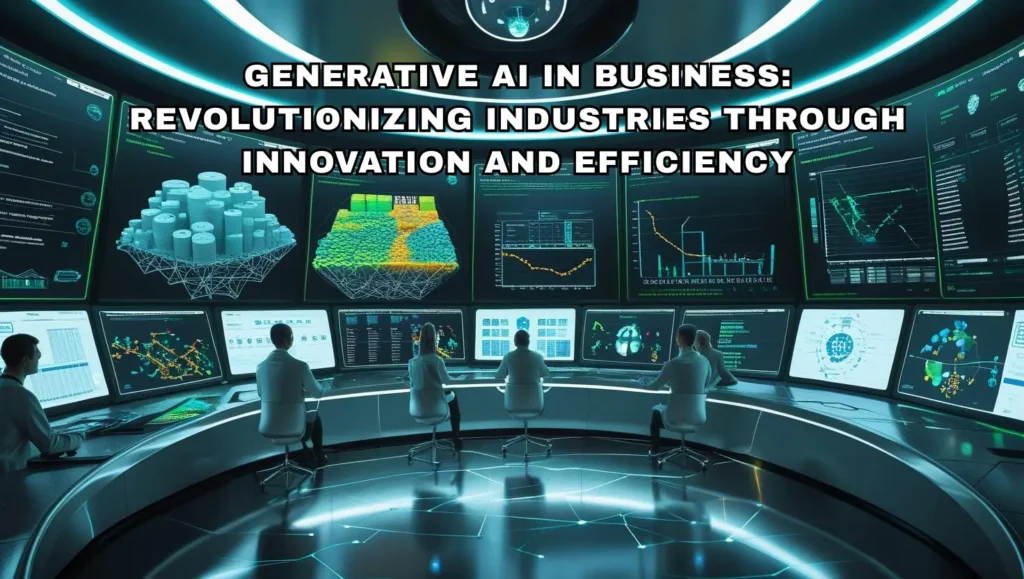Generative AI in business is no longer a futuristic concept, it’s a transformative force reshaping industries, driving productivity, and unlocking unprecedented economic value. With projections estimating that generative AI could add $2.6–$4.4 trillion annually to the global economy, organizations are rapidly adopting this technology to stay competitive. This article explores how generative AI models are being used in business, the scope of business transformation in generative AI, and their practical applications in generative AI in business operations.
How Can Generative AI Models Be Used in Business?
Generative AI’s versatility allows it to augment nearly every business function. Here are key areas where it delivers measurable impact:
1. Enhancing Customer Operations
Generative AI powers chatbots, virtual assistants, and sentiment analysis tools that streamline customer interactions. For example, Volkswagen’s myVW app uses AI to answer driver queries in real time, while UPS leverages AI to predict delivery success rates, reducing operational costs. By automating routine tasks like summarizing support tickets or drafting follow-up emails, businesses improve response times and free human agents for complex issues.
2. Accelerating Marketing and Sales
From personalized ad campaigns to dynamic content creation, generative AI enables hyper-targeted marketing. PODS’ “World’s Smartest Billboard” used AI to adapt advertisements to New York City neighborhoods in real time, generating 6,000 unique headlines in 29 hours. Tools like ChatGPT and Gemini assist in crafting brand-aligned copy, while AI-driven analytics optimize audience segmentation and lead generation.
3. Revolutionizing Software Development
Generative AI acts as a coding copilot, automating up to 50% of software development tasks. Renault’s Ampere subsidiary uses Gemini Code Assist to accelerate code generation, while GitHub Copilot reduces debugging time. This not only speeds up product launches but also allows developers to focus on strategic innovation.
4. Optimizing Supply Chain and Manufacturing
Generative AI improves demand forecasting, inventory management, and logistics. BMW’s SORDI.ai creates digital twins to simulate supply chain scenarios, while Kinaxis uses AI for real-time scenario modeling and risk mitigation. These applications reduce costs and enhance resilience in volatile markets.
5. Empowering Human Resources
Recruitment, onboarding, and employee development are being transformed. AI tools like Allegis Group’s resume-screening models and Dun & Bradstreet’s email-generation systems automate administrative tasks, improving efficiency by 30–40%.
Business Transformation in Generative AI: Redefining Workflows and Roles
The business transformation in generative AI extends beyond automation, it reshapes organizational structures and workforce dynamics. McKinsey estimates that 60–70% of employee tasks could be automated, particularly in knowledge-intensive roles like engineering, R&D, and legal compliance. Key shifts include:
Augmented Decision-Making:
AI acts as a “thought partner,” analyzing trends and simulating scenarios. For instance, a Southeast Asian bank used AI to evaluate market expansions, generating growth projections and competitor analyses in minutes.
Redefined Roles:
While repetitive tasks are automated, employees transition to strategic roles. BCG’s “10-20-70 principle” emphasizes that 70% of transformation efforts must focus on people and processes to succeed.
Ethical and Governance Challenges:
Addressing bias, data privacy, and IP ownership is critical. IBM’s Watsonx and BCG’s GenAI Evaluator provide frameworks to mitigate risks like hallucinations and data leakage.
Generative AI in Business Operations: Driving Efficiency at Scale
Integrating generative AI in business operations requires aligning technology with strategic goals. Successful implementations follow five pillars :
1. Strategic Alignment:
Prioritize use cases tied to core objectives, such as improving customer experience or accelerating R&D.
2. Maturity Assessment:
Evaluate data infrastructure and workforce readiness. Toyota, for example, reduced factory man-hours by 10,000 annually after upskilling workers on AI tools.
3. Technical Optimization:
Adopt modular, cloud-native architectures to scale AI workloads. Google’s Vertex AI and AWS’s Bedrock enable seamless integration with existing systems.
4. Data Governance:
Ensure high-quality, bias-free data. Prewave uses AI to monitor ESG risks in supply chains, relying on clean, auditable datasets.
5. Talent Strategy:
Build interdisciplinary teams with AI engineers, data scientists, and ethical oversight experts.
The Future of Generative AI in Business
The era of generative AI in business is just beginning. As models like GPT-4.5 and Claude evolve, industries from healthcare to finance will see deeper integration. Wharton’s executive programs highlight that leaders who embrace this technology will gain a “make-or-break” competitive edge. However, success hinges on responsible adoption, balancing innovation with ethical guardrails.
Organizations must act now to:
- Invest in proprietary data ecosystems to avoid generic insights.
- Foster a culture of continuous learning to bridge skill gaps.
- Collaborate with regulators to shape AI governance frameworks.
Conclusion:
Generative AI in business is not merely a tool, it’s a catalyst for reinvention. By automating workflows, enhancing creativity, and enabling data-driven strategies, it unlocks trillions in value while redefining industries. From business transformation in generative AI to optimizing generative AI in business operations, the journey requires strategic vision, ethical rigor, and agile execution. The midpoint for automating half of all work activities could arrive by 2045, a decade sooner than prior estimates. The question is no longer “if” but “how” businesses will harness this revolution.
For further insights, explore case studies from Google Cloud, AWS, and IBM on AI-driven strategy development.
FAQs: Generative AI in Business
1. What is generative AI in business?
Generative AI in business refers to the use of artificial intelligence models that create new content, insights, or solutions, such as text, code, images, or simulations, to optimize workflows, enhance decision-making, and drive innovation. Examples include automating customer service responses, generating marketing content, and simulating supply chain scenarios.
2. How can generative AI models be used in business?
Generative AI models are applied across diverse business functions:
Customer Operations:
Automating chatbots (e.g., Volkswagen’s myVW app) and analyzing customer sentiment.
Marketing:
Creating personalized ads (e.g., PODS’ dynamic billboards) and optimizing campaigns.
Software Development:
Assisting with code generation and debugging (e.g., GitHub Copilot).
Supply Chain:
Forecasting demand and simulating risks via digital twins (e.g., BMW’s SORDI.ai).
HR:
Automating resume screening and onboarding tasks.
3. What is the role of generative AI in business transformation?
Generative AI drives business transformation by:
- Automating 60–70% of repetitive tasks in fields like engineering and legal compliance.
- Augmenting human decision-making through predictive analytics and scenario modeling.
- Enabling new business models, such as AI-driven product personalization or real-time supply chain optimization.
4. How does generative AI improve business operations?
Generative AI enhances business operations by:
- Reducing costs (e.g., UPS cutting delivery expenses via predictive analytics).
- Accelerating processes (e.g., Renault’s Ampere using AI to speed up software development).
- Increasing efficiency in HR tasks by 30–40% through automated workflows.
5. What are the risks of adopting generative AI in business?
Key challenges include:
Ethical concerns:
Bias in training data or outputs.
Security risks:
Data leaks or IP ownership disputes.
Technical barriers:
Integration with legacy systems.
Tools like IBM’s Watsonx and BCG’s GenAI Evaluator help mitigate these risks.


